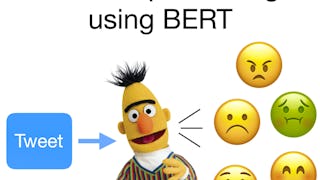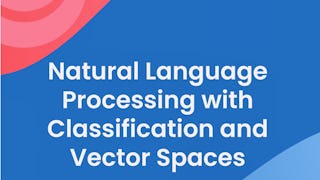This course offers a clear pathway to undertsand advanced tokenization and sentiment analysis—two core pillars of modern NLP. You'll learn how to convert raw text into structured input using subword, character-level, and adaptive tokenization techniques, and how to extract sentiment using rule-based, statistical, and deep learning models.



Advanced Tokenization and Sentiment Analysis
Ce cours fait partie de Spécialisation Mastering NLP: Tokenization, Sentiment Analysis & Neural MT

Instructeur : Edureka
Inclus avec 
Expérience recommandée
Ce que vous apprendrez
Build smarter NLP pipelines with advanced tokenization methods like byte-pair encoding, subword units, and streaming-friendly strategies.
Create powerful text representations using character-level, hybrid, and sentence embeddings for real-world search, classification, and clustering.
Learn sentiment analysis with VADER, machine learning models, and transformer-based approaches like BERT and RoBERTa.
Analyze opinion trends, perform aspect-level and multilingual sentiment analysis, and ensure fairness and accuracy in sensitive applications.
Compétences que vous acquerrez
- Catégorie : Data Cleansing
- Catégorie : Unified Modeling Language
- Catégorie : Data Ethics
- Catégorie : Unstructured Data
- Catégorie : Data Processing
- Catégorie : Natural Language Processing
- Catégorie : Text Mining
- Catégorie : Artificial Intelligence and Machine Learning (AI/ML)
- Catégorie : Machine Learning Algorithms
- Catégorie : Time Series Analysis and Forecasting
- Catégorie : Machine Learning
- Catégorie : Applied Machine Learning
- Catégorie : Large Language Modeling
- Catégorie : Deep Learning
- Catégorie : Data Analysis
Détails à connaître

Ajouter à votre profil LinkedIn
juillet 2025
16 devoirs
Découvrez comment les employés des entreprises prestigieuses maîtrisent des compétences recherchées

Élaborez votre expertise du sujet
- Apprenez de nouveaux concepts auprès d'experts du secteur
- Acquérez une compréhension de base d'un sujet ou d'un outil
- Développez des compétences professionnelles avec des projets pratiques
- Obtenez un certificat professionnel partageable

Il y a 4 modules dans ce cours
In this module, learners will explore advanced techniques for breaking down and encoding text for machine understanding. They will examine subword, byte-level, and adaptive tokenization methods used in modern NLP models. The module also introduces character-level and hybrid embeddings, as well as sentence embeddings for capturing semantic meaning in tasks like search, classification, and clustering.
Inclus
19 vidéos6 lectures5 devoirs1 sujet de discussion2 plugins
In this module, learners will explore the full range of approaches used to analyze sentiment in text, from rule-based lexicons to deep learning with transformer models. They will examine how sentiment is extracted, scored, and classified, and learn how to handle challenges like class imbalance, domain specificity, and low-resource settings. Practical demonstrations will help reinforce the application of models such as VADER, Naïve Bayes, BERT, and RoBERTa in real-world sentiment analysis tasks.
Inclus
16 vidéos5 lectures4 devoirs1 plugin
In this module, learners will examine how sentiment analysis is applied in dynamic, multilingual, and high-impact environments. The lessons focus on tracking sentiment trends over time, extracting aspect-level opinions, and extending sentiment models across languages. Learners will also evaluate the ethical risks of sentiment modeling and explore how to design fair, accountable systems for sensitive applications like healthcare and justice.
Inclus
19 vidéos6 lectures5 devoirs
In this final module, learners will consolidate key concepts from the course through a structured summary, a real-world project, and a reflective assignment. The focus is on applying the full range of tokenization and sentiment analysis techniques in practical, domain-relevant scenarios. This module also encourages learners to evaluate their understanding and prepare for real-world NLP tasks by integrating technical knowledge with ethical and contextual awareness.
Inclus
1 vidéo1 lecture2 devoirs1 sujet de discussion1 laboratoire non noté1 plugin
Obtenez un certificat professionnel
Ajoutez ce titre à votre profil LinkedIn, à votre curriculum vitae ou à votre CV. Partagez-le sur les médias sociaux et dans votre évaluation des performances.
En savoir plus sur Machine Learning
 Statut : Essai gratuit
Statut : Essai gratuit
Coursera Project Network
 Statut : Essai gratuit
Statut : Essai gratuit Statut : Essai gratuit
Statut : Essai gratuitEdureka
Pour quelles raisons les étudiants sur Coursera nous choisissent-ils pour leur carrière ?





Ouvrez de nouvelles portes avec Coursera Plus
Accès illimité à 10,000+ cours de niveau international, projets pratiques et programmes de certification prêts à l'emploi - tous inclus dans votre abonnement.
Faites progresser votre carrière avec un diplôme en ligne
Obtenez un diplôme auprès d’universités de renommée mondiale - 100 % en ligne
Rejoignez plus de 3 400 entreprises mondiales qui ont choisi Coursera pour les affaires
Améliorez les compétences de vos employés pour exceller dans l’économie numérique
Foire Aux Questions
This course provides a deep dive into modern tokenization strategies and sentiment analysis techniques used in multilingual and domain-specific NLP tasks. It explores subword modeling methods like Byte-Pair Encoding (BPE), WordPiece, and SentencePiece, and examines character-level encoding approaches. Learners work with cross-lingual embeddings such as MUSE and LASER, and fine-tune models like mBERT and XLM-R for sentiment classification. The course also covers Aspect-Based Sentiment Analysis (ABSA), lexicon-based methods using VADER and SentiWordNet, and applies these techniques to real-world use cases like social media monitoring, political discourse analysis, and crisis event sentiment tracking.
Learners explore modern tokenization strategies, including Byte-Pair Encoding (BPE), WordPiece, SentencePiece, and character-level encoding, all crucial for subword-level text representation.
Yes. The course emphasizes multilingual and cross-lingual sentiment analysis, using shared subword vocabularies and models like mBERT and XLM-R to handle multiple languages effectively.
Plus de questions
Aide financière disponible,

